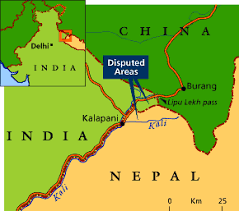What is the issue?
- Due to the Kalapani issue, there is a tension between India and Nepal.
- The relation between the two countries needs a fundamental reset.
Where is Kalapani?
- It is a patch of land near the India-Nepal border.
- It is so close to the Lipulekh Pass on the India-China border.
- [Lipulekh pass is one of the approved points for border trade and the route for the Kailash-Mansarovar yatra in Tibet]

What is the Kalapani dispute?
- India inherited the boundary with Nepal, established between Nepal and the East India Company in the Treaty of Sugauli in 1816.
- The territory to the east of the Kali River was decided as Nepal.
- The dispute relates to the origin of Kali.
- Near Uttarakhand’s Pithoragarh district, there is a confluence of streams coming from Kalapani (north-east) and Limpiyadhura (north-west).
- During British period - The early British survey maps identified the north-west stream, Kuti Yangti, from Limpiyadhura as the origin.
- But after 1857, it changed the alignment to Lipu Gad, and in 1879 to Pankha Gad, the north-east streams.
- Thus, the British survey maps defined the origin as just below Kalapani.
- Nepal accepted the change and India inherited this boundary in 1947.
- After Indian independence - The Maoist revolution in China in 1949, followed by the takeover of Tibet, created deep misgivings in Nepal.
- India was invited to set up 18 border posts along the Nepal-Tibet border.
- The westernmost post was at Tinkar Pass, about 6 km east of Lipulekh.
- By 1969, India had withdrawn its border posts from Nepali territory.
- The base camp for Lipulekh remained at Kalapani.
- In their respective maps, both countries showed Kalapani as the origin of Kali river and as part of their territory.
- The issue of the origin of Kali river was first raised in 1997.
- Boundary Committee - The matter was referred to the Joint Technical Level Boundary Committee that had been set up in 1981.
- In 2008, the Committee clarified 98% of the boundary, leaving behind the unresolved issues of Kalapani and Susta (in the Terai).
- It was subsequently agreed that the matter would be discussed at the Foreign Secretary level.
- Meanwhile, the project to convert the 80-km track from Ghatibagar to Lipulekh into a road began in 2009 without any objections from Nepal.
What is the issue with the maps?
- India’s map - India issued a political map (8th edition) on November 2, 2019, to reflect the change in the status of Jammu and Kashmir.
- Nepal registered a protest though the map in no way had changed the boundary between India and Nepal.
- However, on November 8, the ninth edition was issued.
- The delineation remained identical but the name Kali river had been deleted.
- This led to stronger protests, with Nepal invoking Foreign Secretary-level talks to resolve issues.
- Defence Minister Rajnath Singh did a virtual inauguration of the 80-km road on May 8, 2020, which re-erupted the Kalapani controversy.
- This re-eruption provided Mr. Oli with a political lifeline.
- Nepal’s map - Nepali Prime Minister K.P. Sharma Oli is using the Nepali nationalism card, the flip side of which is anti-Indianism.
- A new map of Nepal was notified on May 20, which was based on the older British survey.
- This map reflects Kali river originating from Limpiyadhura in the north-west of Garbyang.
- The new alignment adds 335 sq km to Nepali territory.
What is the reality?
- Prime Minister Narendra Modi has often spoken of the “neighbourhood first” policy.
- He started with a highly successful visit to Nepal in August 2014.
- But the relationship took a nosedive in 2015 when India first got blamed for interfering in the Constitution-drafting in Nepal.
- It reinforced the notion that Nepali nationalism and anti-Indianism were two sides of the same coin that Mr. Oli exploited successfully.
- The reality is that India has ignored the changing political narrative in Nepal for far too long.
- India remained content that its interests were safeguarded by quiet diplomacy even when Nepali leaders adopted anti-Indian postures.
- For too long India has invoked a “special relationship”, based on shared culture, language and religion, to anchor its ties with Nepal.
- Today, this term carries a negative connotation - that of a paternalistic India that is often insensitive.
What is needed?
- The complexity underlying India-Nepal issues cannot be solved by unilateral map-making exercises.
- Political maturity is needed to find creative solutions that can be mutually acceptable.
- The urgent need is to pause the rhetoric on territorial nationalism.
- A quiet dialogue is needed, where both sides need to display sensitivity as they explore the terms of a reset of the “special relationship”.
- A normal relationship where India can be a generous partner will be a better foundation for “neighbourhood first” in the 21st century.
Source: The Hindu
